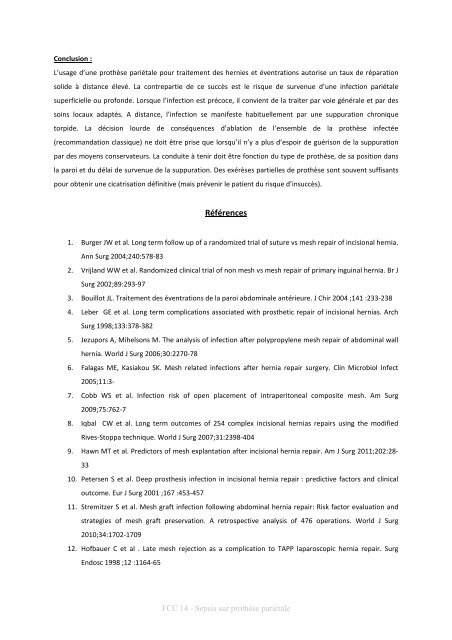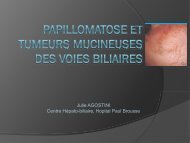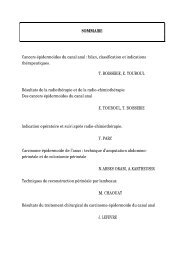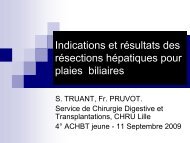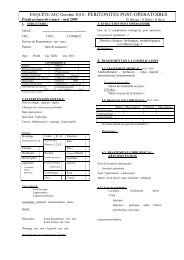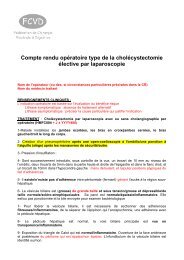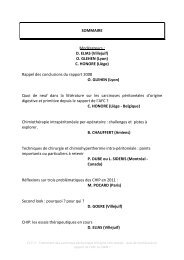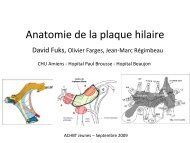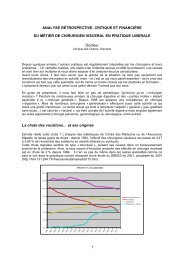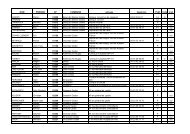Sepsis sur prothèse pariétale - Fédération française de chirurgie ...
Sepsis sur prothèse pariétale - Fédération française de chirurgie ...
Sepsis sur prothèse pariétale - Fédération française de chirurgie ...
You also want an ePaper? Increase the reach of your titles
YUMPU automatically turns print PDFs into web optimized ePapers that Google loves.
Conclusion :<br />
L’usage d’une <strong>prothèse</strong> <strong>pariétale</strong> pour traitement <strong>de</strong>s hernies et éventrations autorise un taux <strong>de</strong> réparation<br />
soli<strong>de</strong> à distance élevé. La contrepartie <strong>de</strong> ce succès est le risque <strong>de</strong> <strong>sur</strong>venue d’une infection <strong>pariétale</strong><br />
superficielle ou profon<strong>de</strong>. Lorsque l’infection est précoce, il convient <strong>de</strong> la traiter par voie générale et par <strong>de</strong>s<br />
soins locaux adaptés. A distance, l’infection se manifeste habituellement par une suppuration chronique<br />
torpi<strong>de</strong>. La décision lour<strong>de</strong> <strong>de</strong> conséquences d’ablation <strong>de</strong> l’ensemble <strong>de</strong> la <strong>prothèse</strong> infectée<br />
(recommandation classique) ne doit être prise que lorsqu’il n’y a plus d’espoir <strong>de</strong> guérison <strong>de</strong> la suppuration<br />
par <strong>de</strong>s moyens conservateurs. La conduite à tenir doit être fonction du type <strong>de</strong> <strong>prothèse</strong>, <strong>de</strong> sa position dans<br />
la paroi et du délai <strong>de</strong> <strong>sur</strong>venue <strong>de</strong> la suppuration. Des exérèses partielles <strong>de</strong> <strong>prothèse</strong> sont souvent suffisants<br />
pour obtenir une cicatrisation définitive (mais prévenir le patient du risque d’insuccès).<br />
Références<br />
1. Burger JW et al. Long term follow up of a randomized trial of suture vs mesh repair of incisional hernia.<br />
Ann Surg 2004;240:578-83<br />
2. Vrijland WW et al. Randomized clinical trial of non mesh vs mesh repair of primary inguinal hernia. Br J<br />
Surg 2002;89:293-97<br />
3. Bouillot JL. Traitement <strong>de</strong>s éventrations <strong>de</strong> la paroi abdominale antérieure. J Chir 2004 ;141 :233-238<br />
4. Leber GE et al. Long term complications associated with prosthetic repair of incisional hernias. Arch<br />
Surg 1998;133:378-382<br />
5. Jezupors A, Mihelsons M. The analysis of infection after polypropylene mesh repair of abdominal wall<br />
hernia. World J Surg 2006;30:2270-78<br />
6. Falagas ME, Kasiakou SK. Mesh related infections after hernia repair <strong>sur</strong>gery. Clin Microbiol Infect<br />
2005;11:3-<br />
7. Cobb WS et al. Infection risk of open placement of intraperitoneal composite mesh. Am Surg<br />
2009;75:762-7<br />
8. Iqbal CW et al. Long term outcomes of 254 complex incisional hernias repairs using the modified<br />
Rives-Stoppa technique. World J Surg 2007;31:2398-404<br />
9. Hawn MT et al. Predictors of mesh explantation after incisional hernia repair. Am J Surg 2011;202:28-<br />
33<br />
10. Petersen S et al. Deep prosthesis infection in incisional hernia repair : predictive factors and clinical<br />
outcome. Eur J Surg 2001 ;167 :453-457<br />
11. Stremitzer S et al. Mesh graft infection following abdominal hernia repair: Risk factor evaluation and<br />
strategies of mesh graft preservation. A retrospective analysis of 476 operations. World J Surg<br />
2010;34:1702-1709<br />
12. Hofbauer C et al . Late mesh rejection as a complication to TAPP laparoscopic hernia repair. Surg<br />
Endosc 1998 ;12 :1164-65<br />
FCC 14 - <strong>Sepsis</strong> <strong>sur</strong> <strong>prothèse</strong> <strong>pariétale</strong>


